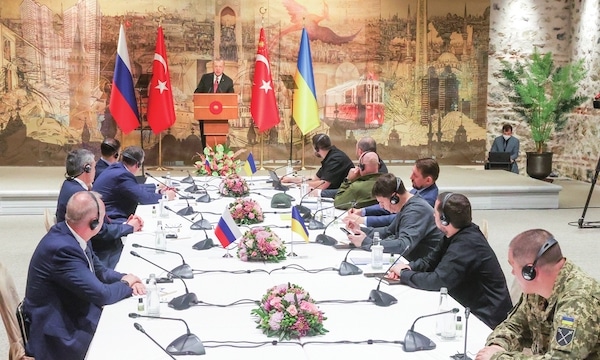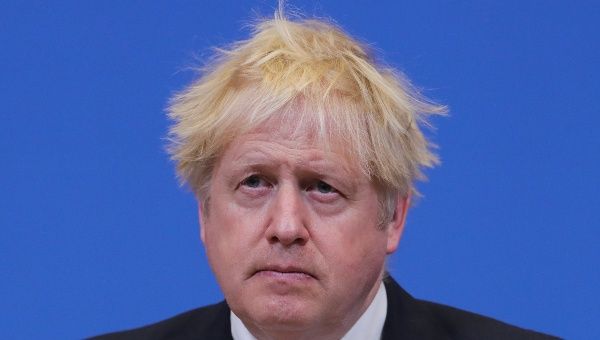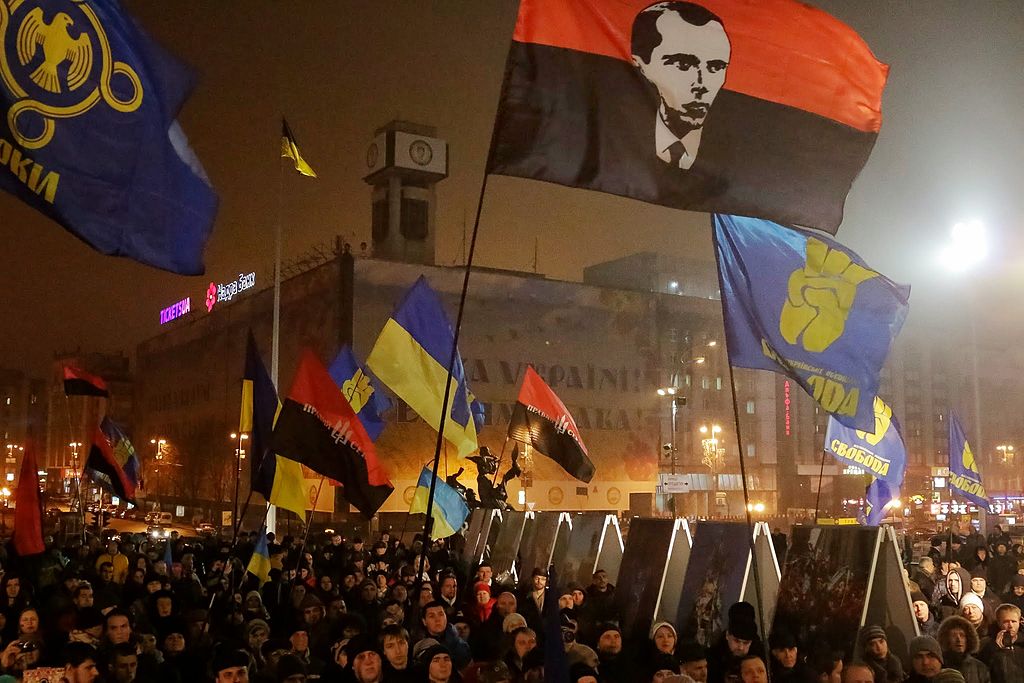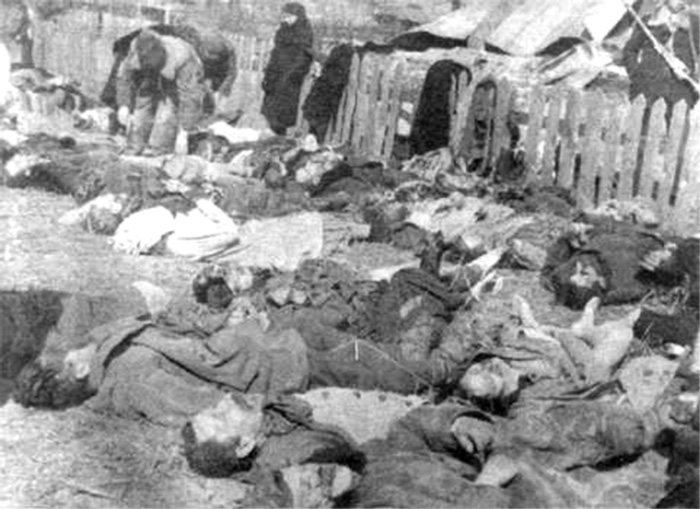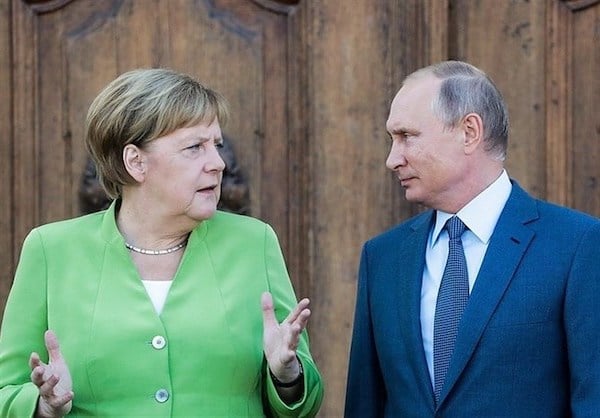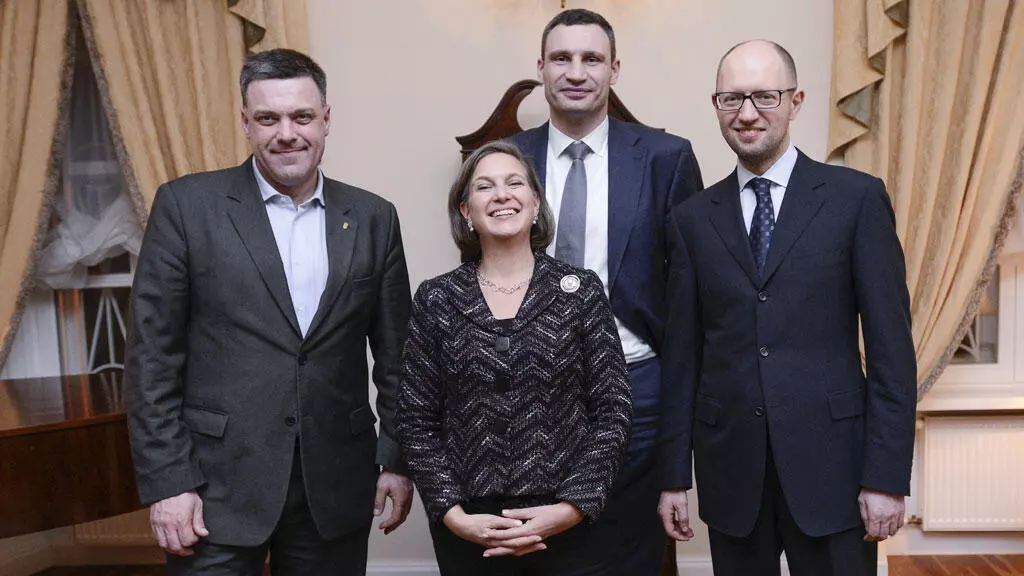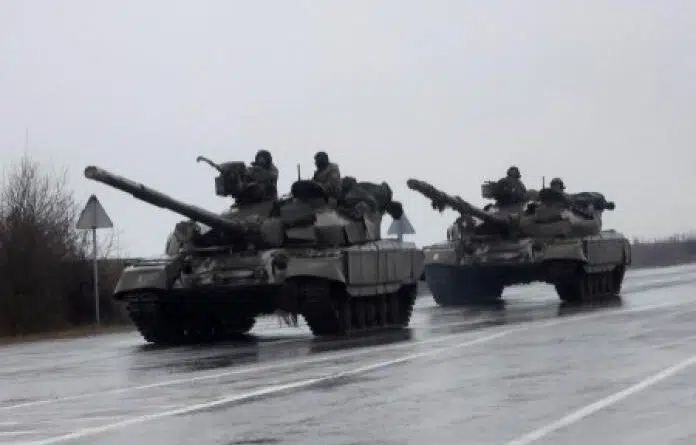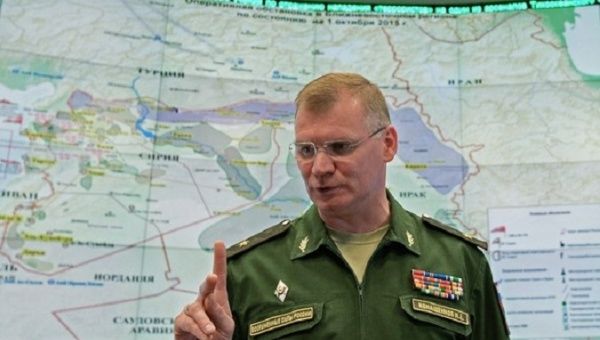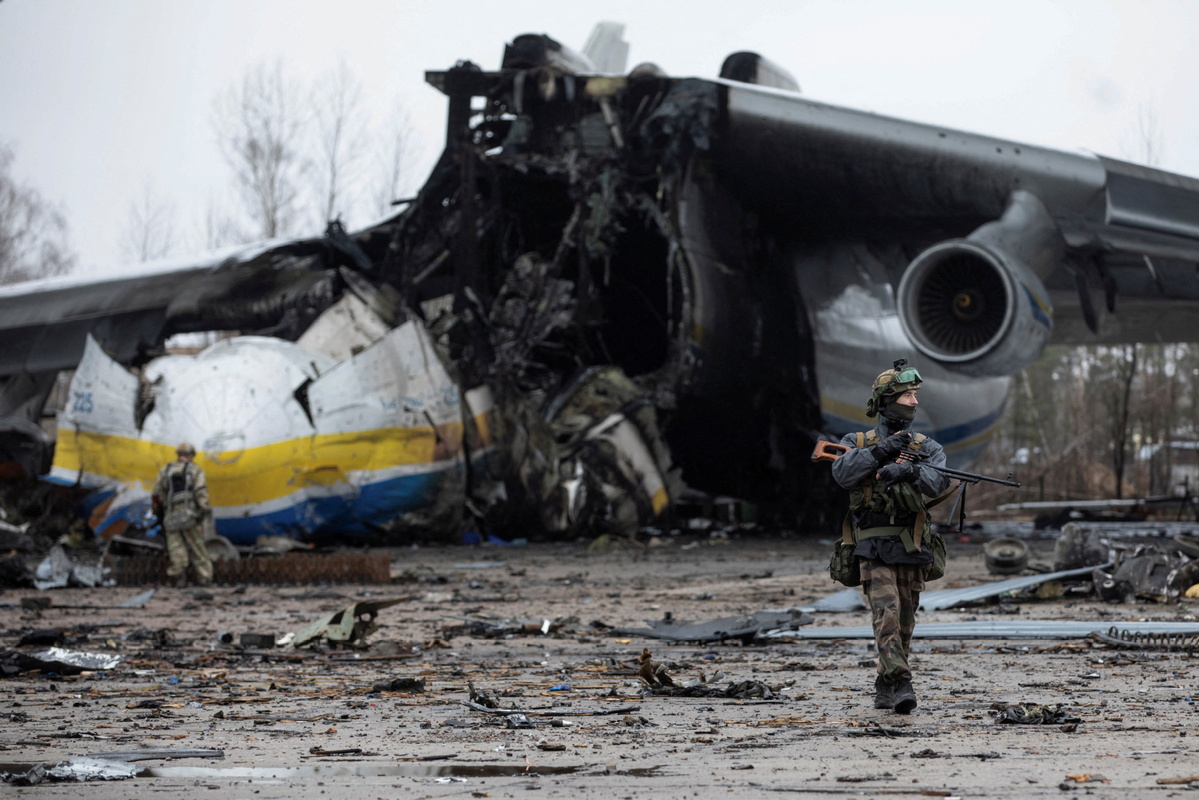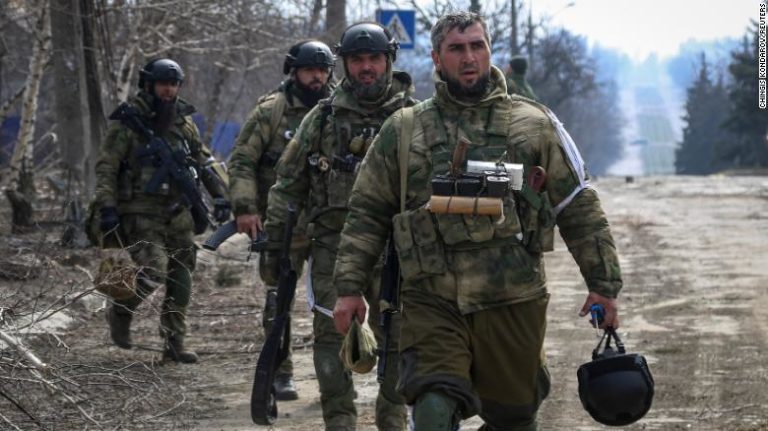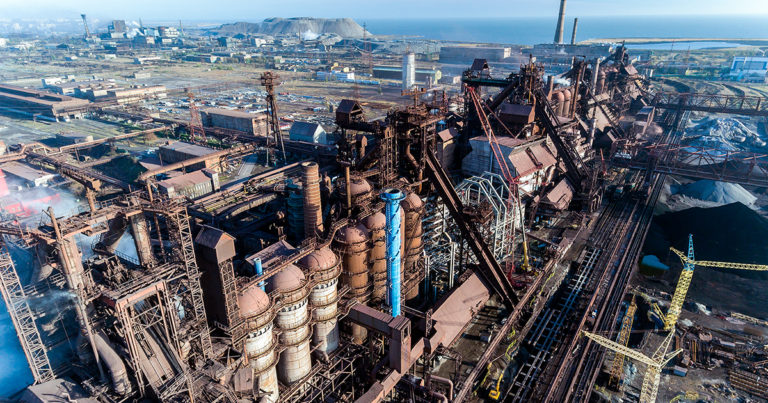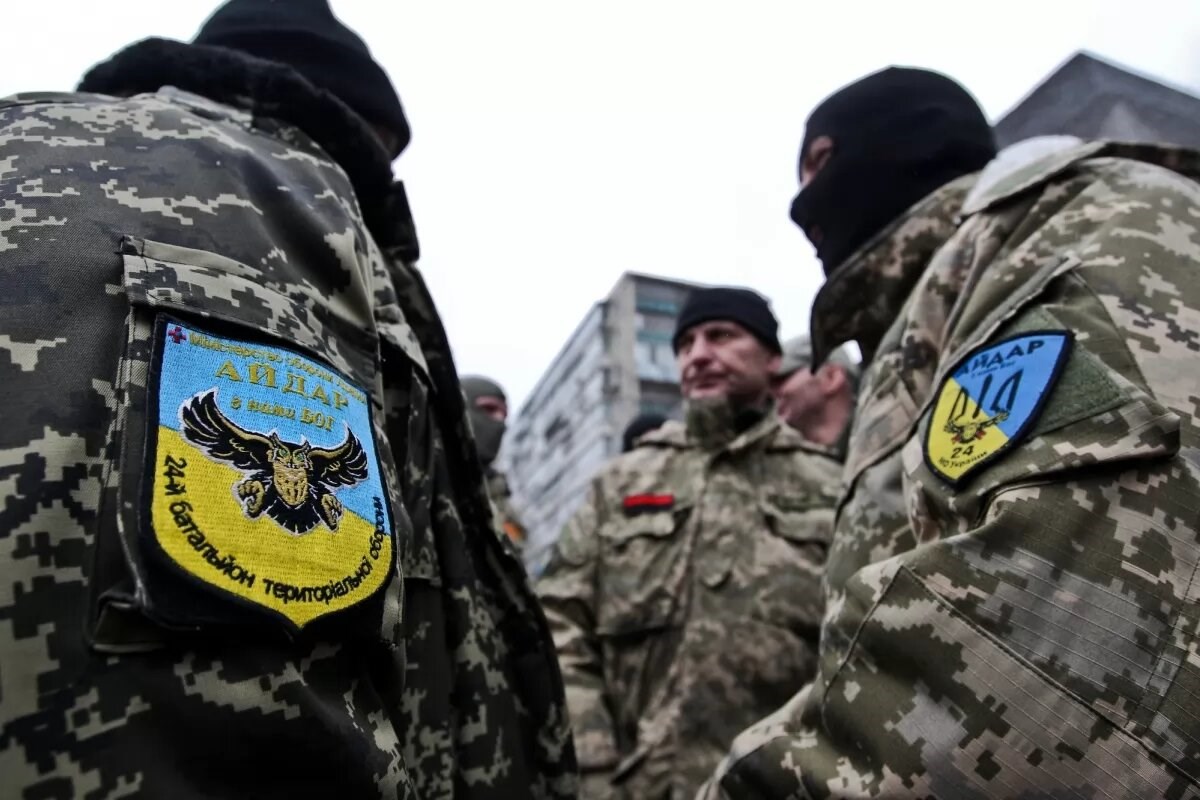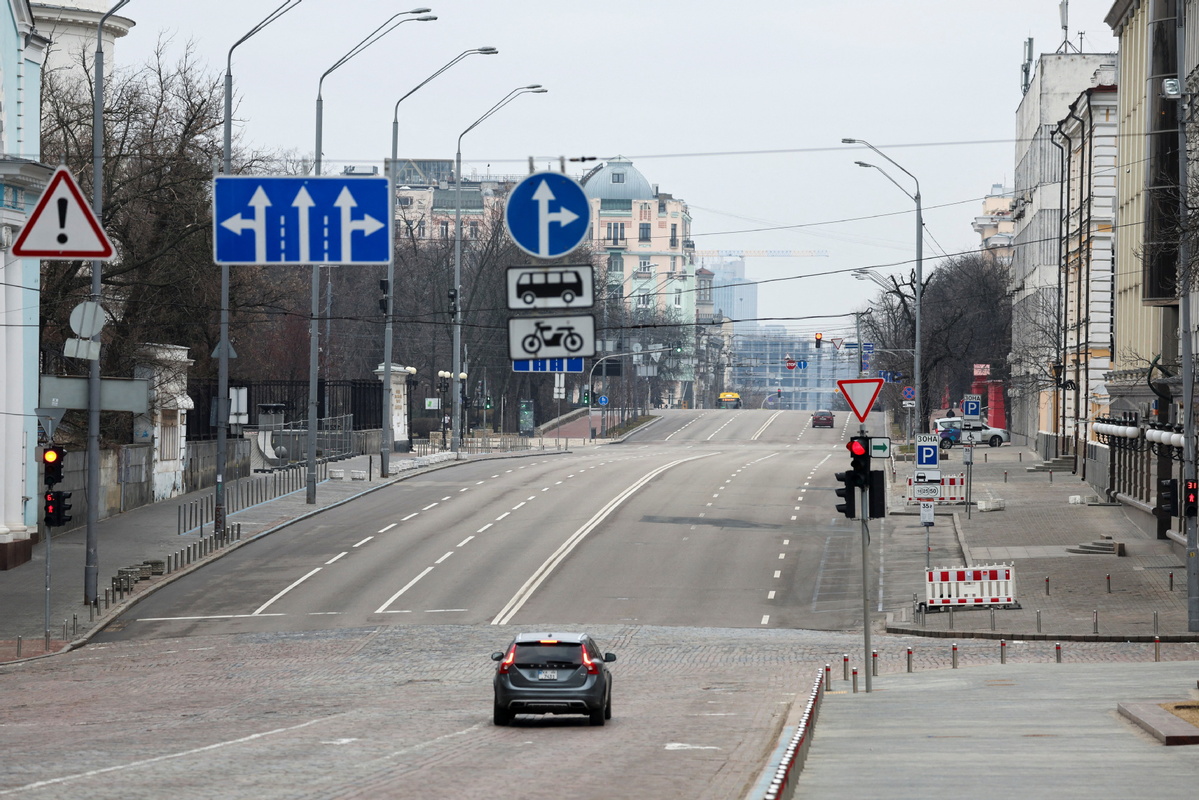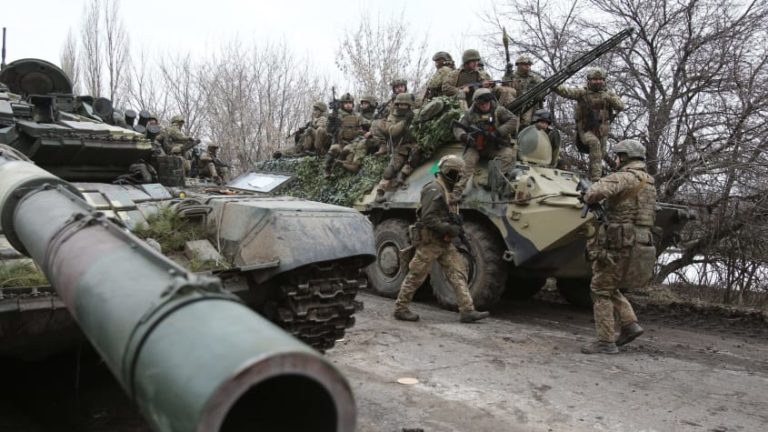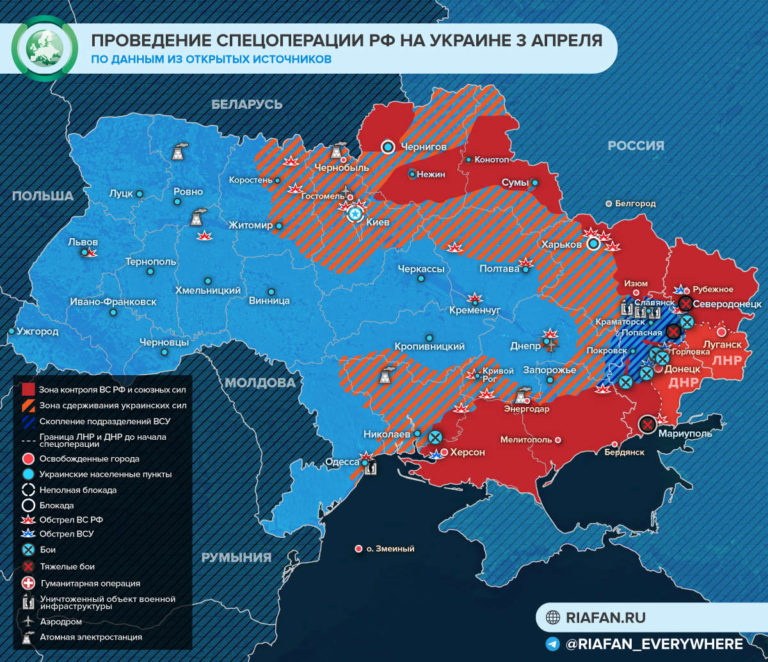colonelcassad
March 31, 23:14

Briefly about Ukraine. 03/31/2022
1. Mariupol.
Street fighting. The ring continues to shrink, but the task of completely blocking Azovstal has not yet been solved. The enemy also holds a piece of the Left-Berzhny region, the western Primorsky part of the city, the port and the factory of Ilyich. Over the past 2 days, the wounded have been evacuated from the port. Out of 6 Mi-8s and 1 Mi-24, 3 Mi-8s were shot down. The rest of the vehicles were able to deliver a certain amount of cargo to Mariupol and take out up to 30 wounded.
The remnants of the enemy forces in Mariupol hysterically demand a deblockade, stating that without it, the defeat in Mariupol will be the greatest shame of Ukraine.
2. Marinka.
A little progress in the village itself. Fights in the slag heap area. Fighting also continues south of Maryinka in the area of Novomikhailovka and Slavny.
3. Carbon.
Fighting continues north of Zolotaya Niva and in the area of Velikaya Novoselka. So far, it has not been possible to get to the Maryinka-Kurakhovo highway.
4. Zaporozhye.
On the line Kamenskoye-Orekhov-Gulyaipole without changes. To the east of Gulyaipol, fighting was noted in the region of Malinovka and settlements to the east.
5. Nikolaev.
Attempts to be active in this direction cost the Armed Forces dearly, and, having suffered heavy losses, the enemy again went on the defensive. The RF Armed Forces continue to accumulate forces in the Kherson region. To the north, near Krivoy Rog and Nikopol, no significant changes were noted.
6. LPR.
Fighting continued in Popasnaya, the southern part of Rubizhne and on the outskirts of Severodonetsk. In general, there are no major developments.
7. Avdiivka.
Avdiivka itself is unchanged. To the north, the troops managed to break through the defenses at Novobakhmutovka and start fighting for the capture of the village, which should help the efforts associated with cutting the rocky road at Novobakhmutovka and Novoselka-2, as well as ensure advancement through Troitskoye to New York and further to Dzerzhinsk.
8. Raisins.
Limited fighting south and southeast of Izyum. Both sides are actively pulling up reserves in this direction, expecting the imminent start of active operations by the grouping of the RF Armed Forces in the Kharkov-Izyum direction. The enemy has created certain reserves in the Artemovsk area, and is also preparing Slavyansk and Kramatorsk for defense. There is also an accumulation of forces in the Pavlograd region, which will act as a strategic reserve in the upcoming battle. Kharkov - battles of local importance.
9. Sumy-Chernihiv.
There is a transfer of significant contingents of the RF Armed Forces to the east. It is not yet clear for what purposes they will be used - for the assault on Sumy or for moving to Akhtyrka and further to Kharkov. There is also the option of transferring part of the forces to the Kharkov-Izyum direction. The pressure on Brovary is currently decreasing. In Chernihiv - no significant changes.
10. Kyiv.
The Armed Forces of Ukraine declare that they were able to restore control over the city of Irpen, but at the same time confirm that Bucha, Vorzel and Gostomel are under the RF Armed Forces. Again they came up with a victory about the capture of Vyshgorod, which was already controlled by the Armed Forces of Ukraine. According to the Pentagon and the Armed Forces of Ukraine, the RF Armed Forces are on the defensive here, and part of the forces are being transferred through Belarus to Kharkov and Izyum.
In general, despite the active battles in different directions, we are now witnessing a kind of operational pause, which is associated with the need to regroup troops and pull up reserves. The main events will soon unfold in Left-Bank Ukraine, where the RF Armed Forces will strive to defeat the main grouping of the Armed Forces of Ukraine. Also, I would not rule out operations in the Nikolaev direction.
Broadcast in Telegram continues as usual here https://t.me/boris_rozhin (if you are interested, subscribe)
https://colonelcassad.livejournal.com/7531043.html
Google Translator
******************************
Ukraine: The Afghanistan Model for the Consolidation of the Global White Supremacist Movement
Ajamu Baraka, BAR editor and columnist 30 Mar 2022

Ukrainian Sports Bar (Image: BBC Panorama 2012 documentary "Stadiums of Hate")
The Biden administration is dusting off the same playbook that gave arms and money to jihadists in Afghanistan and Syria. Now the beneficiaries of American foreign policy largesse are white supremacists from around the world who have made their way to Ukraine.
Hilary Clinton declared during a February 28, 2022 interview with MSNBC that the model for Ukraine should be Afghanistan where the U.S. armed the Afghan mujahideen as part of the U.S. strategy to create a “Vietnamese quagmire .” For Clinton and some elements of the foreign policy community, it is of little concern that the training and real-world military experience and political networking that resulted from bringing radical right-wing Islamicist together created al-Qaeda, the Taliban and later ISIS.
But for African and other colonized people on the receiving end of the U.S. and Western self-centered and opportunist policies, illusions about the real intentions of the White West have usually proven to be deadly. This is even more true in the current crisis of legitimacy and generalized decline of the Western colonial/imperial project. The proclivity of Western imperialism to resort to naked, direct violence to advance its interests and to use anyone and everyone, the possibility that the U.S. would allow extremist right-wing white nationalists and neo-Nazis real-world training, combat experience and networking represents an existential threat.
European colonial history is replete with examples of the divide and conquer tactics of the colonists using one segment of the people to colonize against the other. And since there has been no break with colonialism, no “post-coloniality,” we have witnessed a continuation of those tactics, which today also include the manipulation of nations to wage war against their own national interests in order to advance the interests of the colonial West.
A sad and pathetic contemporary example of this phenomenon is the people of Afghanistan, abandoned and left to starve as the U.S. has moved on. That is why it is so incredible that the people of Ukraine would allow themselves to become the latest cannon fodder for Western imperial vanity and the narrow interests of U.S. capital.
Baiting the Russians into military action was not just a result of miscalculation, no more than the revelation by the Defense Intelligence Agency’s report in 2012 that the Obama Administration’s support for right-wing jihadists in Syria was the result of a “willful” decision. In both cases they understood the possible ramifications, and didn’t care about the consequences.
As soon as the Biden Administration took power, the plan to escalate the situation in Ukraine was executed — a plan that included a clear understanding of the nature of forces behind the newly elected presidential front man for the right-wing Ukrainian oligarchs and U.S. forces that engineered his election. The Biden Administration also understood that the most effective military forces in Ukraine were grouped around and/or associated with various ultra-right and neo-Nazi elements. But who cared when the commitment to “full spectrum dominance” and interests of U.S. finance and corporate transnational capital are driving U.S. policy in Ukraine?
We, the colonized, the working class, the oppressed, must be as cold-blooded and sober in our analysis and actions. Look at how they lied to the public on the existence of ultra-right forces in Ukraine and the nature of that corrupt regime. We will not lie to the people, but we have to separate ourselves from the propaganda when attempting to understand the world.
The U.S. press loudly proclaiming that there was no neo-Nazi influence in Ukraine even though it was common knowledge in the United States and Europe for years that there was always a problem with the extremist nationalist elements in that country. Because of that, the line taken by the U.S. state and the capitalist press after the U.S. engineered coup in 2014 with the extreme right and neo-Nazi forces at the center of the action, was that while those forces’ presence in the street actions was never disputed, the line was that their political significance in the government was minimal.
That line was taken because the historical record was replete with references to the role of the ultra-right in Ukrainian politics since world-war II. And that not only did Ukrainian ultra-nationalists and literal neo-Nazis end up in the new post-coup government in 2014, but the press, human rights organizations, the governments of Europe, and the U.S. were aware of the nature of those forces
That is what made the new line by the liberal corporate press that there was not an issue with the extreme right in Ukraine so bizarre. Apparently, to buttress their drive to war, the new narrative required that the Ukrainian state be represented as the innocent victim of the mad Vladimir Putin, and the presence of ultra-right forces, including neo-Nazis, as a figment of his imagination.
Yet, there is always a method to the madness, in this case the real madness of U.S. imperialism.
The Opportunism of the Neoliberal Right: From al-Qaeda to White Supremacists in the Service of the Lords of Capital
Victoria Nuland, under-secretary of State for Eastern Europe and the primary on the ground coordinator of the 2014 coup, with Joe Biden as the overall point person for the Obama Administration, were all absolutely clear about the nature of neo-fascist forces in Ukraine like the Right Sector and the Azov Battalion.
In fact, that was precisely why those elements were used as muscle during the violent street fights leading up to the coup. It is also why they were unleashed against their fellow Ukrainian citizens in Eastern Ukraine when they rejected the legitimacy of the coup government.
U.S. authorities also understood then as they understand today that those neo-fascist forces represented a dangerous, if one is concerned about violent right-wing white supremacists, development for the global white supremacist movement that saw Ukraine as a liberated territory after 2014.
A 2018 FBI affidavit asserted that Azov “is believed to have participated in training and radicalizing United States–based white supremacy organizations,” including members of the white supremacist Rise Above Movement, prosecuted for planned assaults on counter protesters at far-right events, including the Charlottesville “Unite the Right” rally.
The danger was seen as so serious by some members of the U.S. Congress that in 2019 New York Rep. Max Rose, who chairs the counterterrorism subcommittee, submitted a letter to the State Department, co-signed by 39 members of Congress, that urged the department to add the Azov Battalion to the list of “Foreign Terror Organizations.”
Also in 2019, Jewish groups accused the Canadian government of training neo-Nazi organizations in Ukraine, despite warnings in 2015 from the same organizations that track the ultra-right that the Ukrainian military was saturated with neo-Nazi elements.
In 2020, FBI director Christopher Wray revealed that the agency was “monitoring very closely a trend that may be starting to emerge, … of neo-Nazi actors here in the US who are communicating online with similar like-minded individuals overseas.”
Yet, in 2021 it was clear that the Biden Administration, along with their Canadian and British allies, could not care less about organized white supremacy as a threat. Their objective was to mobilize public opinion to support their hybrid war against Russia.
To do that, they portrayed the war in Ukraine as a struggle of liberalism against authoritarianism, good versus evil. As Zelenskyy played his greatest role, appealing to “freedom fighters” to come and fight in Ukraine, it did not matter to him or Westerners that while the foreign fighters who arrived were a mix of radical Islamists, naïve liberals, and pan-Turkists, the overwhelming majority were ultra-right supremacists and neo-Nazis from across Europe and the U.S.
According to the Kiev governement, by March 6 at least 20,000 foreign fighters from 55 countries had entered Ukraine to fight against Russians. And just as in Afghanistan in the 1980s, the CIA is also involved in training special Ukrainian forces, that includes elements from the Azov forces, even though current and former intelligence officials predict a new “al-Qaeda,” a “transnational white supremacist network,” with alleged ties to the Ukraine conflict will be the next global catastrophe to befall the world as the threat of COVID-19 recedes.”
The U.S. oligarchy is clear. The war they baited the Russians into signals a return to waging wars of domination in Europe to augment the imperialist wars waged for the last 77 years in the global South. Now members of the European proletariat are dying on all sides and the people are shocked.
Violence has been key to the parasitic reality of the European project. The West under bourgeois rule has demonstrated it is prepared to maintain global hegemony through “any means necessary.” If that means the establishment of a cross-class white supremacist coalition under the political rule of the petit-bourgeois that they control (the classic fascist European configuration of class relations under fascism), they will do that.
The dog and pony show with their fake concerns about Trump and then aligning with neo-fascist, white supremacist forces in Ukraine should under normal circumstance result in a shift of consciousness that rejects all of the crude ideological attempts to hide the reality of white minority class rule. But these are not normal times. The power of the capitalist class to control narratives, and the objective reality that millions of people have been moved to global information platforms owned and controlled by capital that is now involved in systematic thought policing and suppression, is creating a narrowing dystopian counter-reality for the radical anti-capitalist forces.
And for those of us in the African revolutionary movement, it is becoming quite clear that, along with Palestinians, we are alone. We cannot depend on the petit-bourgeois settler white left that consistently demonstrates a conservative and collaborative tendency toward national chauvinism ,the class struggle and the ongoing fight for national liberation and self-determination of peoples and nations. It is also blind to the existence, let alone the influences, of normalized white supremacist ideology. For them white supremacy is representative of people like Trump as opposed to Obama.
But colonial/capitalist white supremacist patriarchy is not reducible to race or any other socially ascribed categories. It is a system of power that must be overthrown if we are to survive.
https://www.blackagendareport.com/ukrai ... t-movement
***********************************
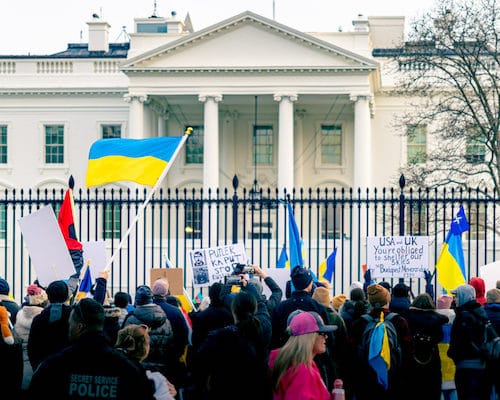
Ukraine and the Global economic war: barbarism or civilisation?
Originally published: Peoples Democracy by Prabir Purkayastha (March 27, 2022 ) | - Posted Mar 30, 2022
DOES the Ukraine war and the action of the U.S., EU, and the UK spell the end of the dollar as the world’s reserve currency? Even if the peace talks between Russia and Ukraine reach a 15-point peace plan, as Financial Times has reported, the fallout for the dollar still remains. For the first time, a major nuclear power and major economy were treated as a vassal state. Its $300 billion foreign exchange reserves lying with the U.S., EU and the UK were seized.
The threat to the dollar hegemony is only one part of the fallout. The other is the complex supply chains, built upon the promise of a stable trading regime based on the WTO principles, is also threatening to unravel. The U.S. is discovering that Russia is not simply a petro-state as they thought but supplies many of the critical materials that the U.S. industry and the military need. This is apart from Russia being one of the critical suppliers of wheat and fertilisers globally.
Seizing Russia’s funds means that the faith the U.S. is the world’s banker and the dollar is the global reserve currency, is in question. Why should countries maintain any trade surplus and bank it abroad if that surplus can be seized at will? The promise of a dollar as the world’s reserve currency was that all surpluses in dollars were safe. With the seizing of the Afghan central bank’s 9.5 billion dollars recently, the U.S. had shown that it considers that dollars held by another country with the U.S. central banks as a fair game. It may be an economic asset in the books for a country. But it is effectively a political liability, as the U.S. government can seize this asset at its will. This was also shown earlier in Iraq, Libya, Venezuela. Seizing Russia’s foreign exchange reserves by a handful of western countries–ex-colonial and settler-colonial states–means that the so-called rules-based order is now based on weaponising the dollar and the west’s control over the global financial system.
Economists–Prabhat Patnaik, Michael Hudson–and financial experts such as Zoltan Potsar of Credit Suisse are now predicting a new regime in which the Chinese Yuan or a variant of it will emerge as the world’s new reserve currency.
Why these predictions? After the Second World War, the Bretton Woods agreement led to the dollar becoming the world’s reserve currency. It replaced the British pound and was pegged to gold, with $35 to an ounce of gold. In 1971, President Nixon removed the U.S. dollar from the gold standard, which meant that the dollar was now backed only by the U.S. government (or U.S. Treasury) guarantees. In the post-war years, the dollar as reserve currency had three things going for it. It was backed by the U.S., which was the world’s largest industrial producer; the U.S. was the pre-eminent military power even if challenged by the Soviet Union; and it was backed by West Asian oil, the largest traded commodity, being priced in dollars.
The denomination of West Asian oil, particularly of Saudi Arabia, was critical to the U.S. and was determined by its military power. The coup in Iran against Mosaddegh, the 1963 coup in Iraq, and many other political events there can be understood more easily, if we understand why oil was so important to the U.S.. This was the basis of the Carter doctrine, extending the Monroe doctrine equivalent to the Persian Gulf Region. Or what the cartoonists drew: “Our oil is under their sand”. The U.S. control over West Asian oil and its industrial and military power ensured that the dollar remained as the world’s reserve currency.
The fall of the U.S. as the world’s industrial power has gone hand in hand with the rise of China. A measure of China’s industrial rise can be seen from a simple statistic given by Lowy Institute using IMF data on global trade. In 2001, over 80 per cent of countrie s had the U.S. as their major trading partner. By 2018, that figure had dropped to a little over 30 per cent– 128 out of 190–and had China as their major trading partner. Not the United States. This dramatic change has happened in less than 20 years! The reason for this change is industrial production: China overtook the U.S. in 2010 to become the largest industrial producer in the world (https://www.statista.com). India is the fifth largest industrial producer but produces only 3.1 per cent against 28.7 per cent by China and 16.8 per cent by the U.S.. It is not surprising that trade follows industrial production.
Two recent events are important in this context. China and the Eurasian Economic Union consisting of Russia, Kazakhstan, Kyrgyzstan, Belarus and Armenia seem to be moving towards a new international and monetary system. India and Russia also seem to be working out a rupee-rouble exchange based on India’s need to import Russian arms, fertiliser, and oil. India had already created a similar system earlier for buying Iranian oil. This might also give a fillip to increasing India’s exports to Russia. Saudi Arabia has recently indicated that it might also designate its oil sales to China in Yuan and not dollar. After 1974, this is the first time Saudi Arabia would sell any oil in a currency other than the dollar. This means an immediate fillip to the yuan, as 25 per cent of all Saudi Arabia’s oil is sold to China.
The U.S. dominates the services, intellectual property and information technology markets. But all of them are based on a complex of supplies and, therefore, complex global supply chains. If the western economic war means taking out Russia’s supplies from the global market, many supply chains are in danger of unravelling. I have already written about the energy war and how European Union depends on gas piped from Russia to Europe. But there are many other commodities that are critical for not only those sanctioning Russia but also those who may find it difficult to trade with Russia as a consequence of the west’s sanctions.
Strangely enough, one of the key elements in the supply chain for manufacturing chips depends on Russia. This is sapphire substrates (using artificial sapphires) that go into chips, of which Russia seems to have a near-monopoly. The other threat is neon gas supplies to chip makers. The major neon gas suppliers are in southern Ukraine, one in Mariupol and the other in Odessa. They together produce about 50 per cent of global neon supply and 75 per cent of the supply to the world’s chipmakers.
I have already highlighted earlier the danger to EU’s climate change plans and its shift to gas as a bridge fuel. Using batteries as the key storage element in the renewable energy route also has a substantial Russian weakness. Nickel is critical for electric batteries, and the largest supplier of nickel in the world is Russia. With the U.S. and EU imposing sanctions, this may lead to China, already emerging as the world’s largest battery supplier, creating an even more dominant position.
The other supply chain issues are palladium, platinum, titanium, and rare earths. All of these are required by advanced industries, creating supply chain bottlenecks worldwide. They are also on the list of 50-strategic materials that the U.S. needs. If we remember how the supply chains seized up during COVID-19, the coming crisis could be a lot worse. Sanctions are easy to impose, much harder to lift. And even after the lifting of sanctions, the supply chain will not come together seamlessly as it did before. Remember, these supply chains have been incrementally configured over decades. Undoing them using the wrecking ball of sanctions is easy; redoing them is a lot harder.
The food supplies to the world will be hit even harder. Russia, Ukraine and Belarus produce a significant amount of fertilisers needed by farmers everywhere. Russia and Ukraine are among the biggest exporters of wheat. If Russian wheat is sanctioned and Ukraine’s harvest is hit due to war, the world will not find it easy to thwart a severe food shortage.
There is no question that the world is on a cusp. It will either lead to the complete destruction of the Russian economy, even if Russia achieves a quick peace in Ukraine and there is no NATO-Russia War. Or it will reconfigure a new economic order which has been in the offing: a world order with cooperative solutions instead of military and economic wars.
https://mronline.org/2022/03/30/ukraine ... ilisation/
************************
Europe's Plan To Boost LNG Imports From US, Elsewhere Faces Major Obstacles
BY TYLER DURDEN
WEDNESDAY, MAR 30, 2022 - 04:15 AM
European leaders have grown quite fond of bandying about the notion of liberating their economies from their dependence on Russian oil and gas. Unfortunately, the numbers just don't make sense.
On Tuesday, the FT highlighted how Washington's pledge to wean Europe off of Russian gas by boosting LNG exports simply doesn't add up.
As a reminder, the US plan is supposed to work in three steps: first, it will help the EU secure short-term liquefied natural gas supplies to begin displacing Russian gas. Second, Europe will work "toward the goal of ensuring" a bigger market for US gas by 2030. Third, the US would help Europe accelerate its transition to clean energy.
But how much more gas can the US even export? Limits on both exporters' capacity and Europe's infrastructure and ability to absorb gas imports by boat suggest that, for the foreseeable future, the notion of offsetting Russian energy exports is pretty much a pipe dream.
The US says it aims to add 15 billion cubic meters of LNG to the EU this year, with more in the years to come. It didn't specify the origins of the gas, noting it would "work with international partners". By comparison, Russia currently exports 155 billion cubic meters a year of gas to the EU.
However, the baseline for this 15 billion pledge isn't clear. While the US shipped about 22 billion cubic meters of gas to Europe in 2021, it has already sent about 10 billion in the first quarter of this year. All of it is in the form of LNG, which is much more expensive to ship than gas that flows through a pipeline (as most of the Russian gas arriving in the bloc does).
Since October, America's LNG exports to Europe have already more than doubled.
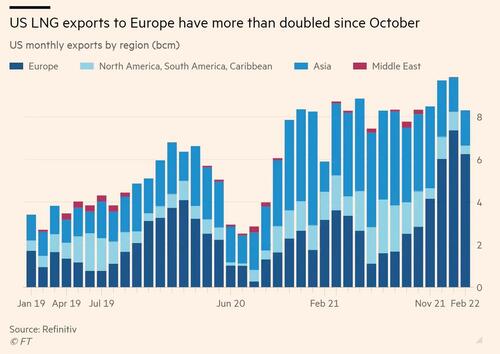
Source: FT
Looking ahead, a team of analysts at Goldman Sachs warned clients in a recent research note that there's little scope for the US to boost LNG exports between now and 2025.
Another major obstacle to replacing Russian gas with American (or Qatari, or Saudi or Australian) LNG is the lack of necessary infrastructure available in Europe. LNG must be carefully offloaded and "regasified" from its liquid state after arriving at its destination. And most European countries simply don't have the necessary infrastructure to accomplish this. Perhaps this is why European Commission President Ursula von der Leyen has called on the EU to "pool its resources", while Germany has suggested renting floating "regasification" vessels.
And even though the bloc's energy situation is more precarious than it has been in years, the clean-energy partisans are have vehemently opposed the construction of more of this LNG infrastructure for fear that it could undermine their agenda of renewables-first.
This is a U-turn from previous EU purchasing decisions as many buyers had stopped negotiating with US developers for LNG due to ESG [environmental, social and governance] concerns,” said Sindre Knutsson at Rystad Energy, a consultancy.
Environmentalists were scathing. “Allowing for the expansion of new and expanded gas export facilities would lock in decades of reliance on risky, volatile fossil fuels and spell disaster for our climate,” said Kelly Sheehan at the Sierra Club.
Even if Europe did manage to rapidly build out the infrastructure (which is unlikely, given the opposition from the ESG fanatics), they would likely have trouble convincing exporters to cut them in. After all, why would the Saudis (who have so far steadfastly refused to boost production in the face of the Ukraine conflict), or the UAE reroute their oil and gas from rapidly growing Asian markets (where demand is expected to remain robust for years to come) to Europe (where any short-term increase in demand is expected to be quickly offset by the bloc's pivot to renewables?).
That's a question President Biden and his European compatriots have been struggling to answer.
https://www.zerohedge.com/energy/why-us ... ussian-gas
Germany Scrambles To Ration Gas After Refusing To Make Payments In Rubles
BY TYLER DURDEN
WEDNESDAY, MAR 30, 2022 - 07:04 AM
Update (1140ET): It looks like Moscow is making headway with its demands that "hostile states" (aka its European customers) start paying for their gas in rubles. According to Bloomberg, Putin and German Chancellor Scholz have agreed to let 'experts on both sides' discuss the feasibility of Russia's demand that Germany switches to rubles for its gas payments, according to an emailed statement from the Kremlin.
Both leaders have agreed that switching to ruble payments shouldn’t deteriorate contract terms for European importers of Russian gas (meaning that the price should remain stable regardless of which currency is used for payment and settlement). Putin also updated Scholz on the state of talks between Russia and Ukraine.
But Scholz isn't the only European leader who appears to be seriously considering Putin's demands. Italian leader Mario Draghi is also reportedly considering Putin's demands.
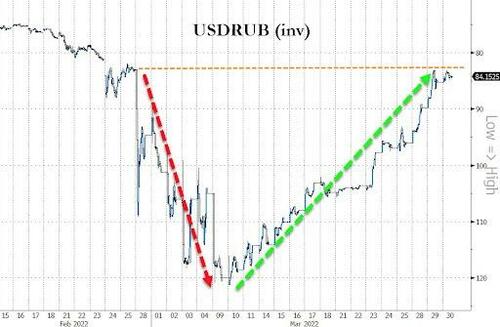
Now that Moscow has doubled down on its demands that its European "partners" pay for its oil and gas in rubles instead of euros (which, as the bloc already demonstrated, can be easily confiscated in the name of "sanctions"), the German government is digging in its heels as the payment dispute threatens to precipitate problematic energy shortages in Europe's largest economy.
The FT reported Wednesday that German Energy Minister Robert Habeck has activated the "early warning phase" of Germany's gas emergency law, which was adopted to help ration supplies in the face of a severe shortage. The decision will alert German consumers and businesses to do what they can to conserve energy.
Too bad President Biden and the US will take years to reroute their promised LNG exports (and even so, they will likely never be able to fully compensate for Russian supplies).
Habeck issued the warning for fear that Moscow would swiftly move to cut off energy exports to one of its biggest customers in Europe over its refusal to make payment in rubles, which Habeck has insisted would be a violation of the two sides' contract.
The move was triggered by German concern that Russia might cut supplies to the country and its neighbors because they are rebuffing Moscow’s efforts to force payment for gas imports in rubles.
After demanding last week that "hostile states" pay for its gas and oil in rubles (although it hinted that gold and cryptocurrency might also be considered), Moscow said it wouldn't share its resources "for free" after the G-7 aggressively repudiated the Russians' request.
"We will definitely not supply oil and gas for free, that's for sure. It's hardly possible and reasonable to engage in charity in our situation," Putin spokesman Dmitry Peskov said earlier this week.
As Germany scrambles to address a looming shortfall in energy supplies, analysts are warning that the government's refusal to meet Moscow's request for payment in rubles could create a "substantial" risk.
During the early warning phase - the first of three stages in Germany’s emergency response - a crisis team from the economics ministry, the regulator and the private sector will monitor imports and storage.
If supplies fall short, and less draconian attempts to lower consumption do not work, the government would cut off certain parts of German industry from the grid and give preferential treatment to households.
Volker Wieland, a professor of economics at Frankfurt University and a member of the German council of economic advisers, on Wednesday warned that a halt in Russian energy supplies would create a “substantial” risk of a recession and bring Europe’s largest economy "close to double-digit rates of inflation."
Already, the German economy is facing its most brutal inflation in decades, with an annual headline inflation rate that could top 6% by the end of the year. The dire situation has already prompted the government to subsidize citizens' energy costs with a round of energy stimmies.
Further restrictions on Russian supply could have even more dire consequences.
As a reminder, Russia dominates gas and oil exports to the EU:

Source: FT
Of course, if Berlin doesn't play ball, gas won't be the only commodity in short supply. The Kremlin said on Wednesday that demanding ruble payments for exports of oil, grain, fertilizers, coal, metals and other key commodities in addition to natural gas was a good idea, Russia's top lawmaker Vyacheslav Volodin said on Wednesday, per Reuters.
"If you want gas, find rubles," Volodin, the speaker of the lower house of parliament, said in a post on Telegram.
Peskov, meanwhile, said the dollar's global reserve currency was already diminishing, and that pricing Russia's biggest exports in rubles would be "in our interests and the interests of our partners."
Now, if the leaders of Europe don't play ball, then President Biden's prediction of devastating food shortages could become a self-fulfilling prophecy.
https://www.zerohedge.com/energy/german ... nts-rubles
